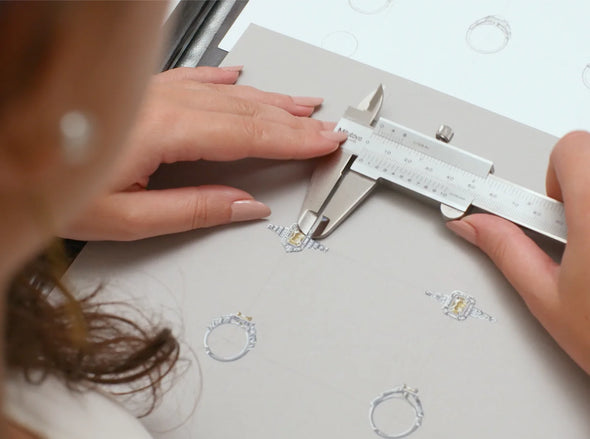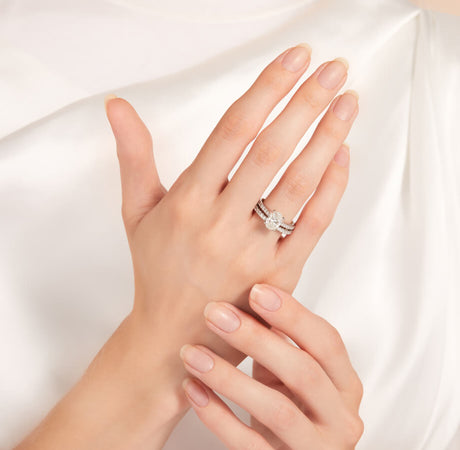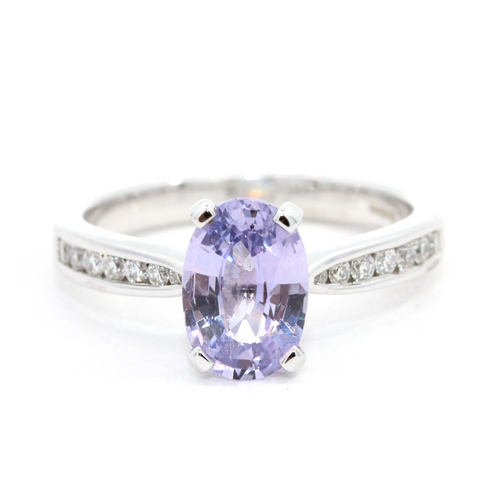From our GIA experts
Oval Cut Guide
When it comes to marking a meaningful milestone, choosing the right diamond is a personal and important decision. The oval cut offers a timeless blend of brilliance and elegance, with a flattering, elongated shape that feels both classic and contemporary. This guide is designed to help you explore the key features of oval cut diamonds, so you can make a confident and informed choice.
Oval 4cs
Choosing an Oval Diamond: Factors to Consider
When it comes to choosing a diamond that balances classic beauty with modern appeal, the oval cut is a standout choice. Its elongated shape not only flatters the finger but also maximises visual size, often appearing larger than other shapes of the same carat weight. This guide will walk you through the key considerations for selecting an oval diamond, helping you make a choice that’s as refined as it is radiant.
The Best Ratio for an Oval Cut Diamond
The length-to-width ratio significantly influences the overall look of an oval cut diamond. A ratio between 1.35 and 1.50 is typically considered ideal, offering a balanced, elongated shape that flatters the finger without appearing too narrow or too round. Preference plays a key role—some may prefer a longer, slimmer profile, while others may opt for a slightly wider, softer silhouette.
Oval Cut Guide
Cut quality is essential when choosing an oval diamond, especially because this shape can show a bowtie effect—a shadow across the center caused by light leakage. While some bowtie is common, it should not dominate the diamond’s appearance. Look for excellent symmetry and proportion, with well-aligned facets that reflect light evenly and maximize brilliance.
Oval Colour Guide
Due to their large surface area, oval cut diamonds can show more body color than round brilliants. For a bright, colorless look—especially in white gold or platinum—opt for a color grade of H or higher. In yellow or rose gold settings, I or J color diamonds can still appear warm and beautiful without compromising on visual appeal.
Oval Clarity Guide
Oval cuts tend to mask inclusions better than emerald or asscher cuts but not as well as round brilliants. Look for a clarity grade of VS2 or higher, or choose an eye-clean SI1 to maximize value. Avoid prominent inclusions near the center of the stone, where they may be more visible due to the oval’s open table.

How to choose an oval diamond
Buying Guide
The oval cut is a modified brilliant cut, meaning it shares the same facet structure as a round brilliant but in an elongated, oval-shaped silhouette. As a member of the fancy cut family, the oval cut offers the brilliance and fire of a round diamond while creating a softer, stretched appearance that flatters the hand. Its graceful shape and radiant sparkle make it a popular and versatile alternative to traditional cuts.
-
Length-to-Width Ratio:
Oval diamonds typically range from 1.30 to 1.50. A lower ratio gives a fuller shape, while a higher ratio creates a more elongated, elegant look.
Facets:
With 58 facets, the oval cut mirrors the brilliance of a round diamond while offering a softer, stretched silhouette.
Bowtie Effect:
Oval cuts can show a bowtie effect—a faint shadow across the center. The visibility depends on cut quality and varies from stone to stone.
-
Length-to-Width Ratio:
Oval diamonds usually range from 1.30 to 1.50. A longer ratio elongates the finger, while a rounder shape gives a softer, more classic look—choose based on personal preference.
Facets:
Like the round brilliant, oval cuts feature 58 facets, designed to maximize sparkle and brilliance across the elongated shape.
Bowtie Effect:
Most oval diamonds show some bowtie effect—a shadow across the center. Look for well-cut stones where this is minimal and doesn’t distract from overall brilliance.
-
Solitaire:
A single oval diamond on a simple band highlights the stone’s elegance and flattering shape, allowing its brilliance to take center stage.
Halo:
A halo of smaller diamonds surrounding the oval cut adds extra sparkle and enhances the overall size and presence of the ring.
East-West Setting:
Placing the oval diamond horizontally offers a modern, unconventional twist on a classic shape—perfect for a distinctive, fashion-forward look.

Oval Origins
History of Oval Cut
The oval cut diamond, known for its elongated, symmetrical shape and brilliant sparkle, is a modern interpretation of the classic round brilliant. First popularized in the 1950s, the cut was refined and formalized by diamond cutter Lazare Kaplan in 1957, who sought to combine the fire of a round diamond with a more unique, elongated silhouette. Its shape offers excellent finger coverage and visual size, making it a favorite among those seeking both elegance and impact. Today, the oval cut remains one of the most sought-after fancy shapes for its timeless beauty and flattering proportions.
Ring Styles & Inspiration
Kourtney Kardashian’s engagement ring from Travis Barker features a stunning oval-cut diamond, estimated between 10 and 12 carats. Set on a delicate pavé band with a hidden halo, the ring’s elongated silhouette and bold presence perfectly reflect her refined, yet edgy aesthetic.
Zendaya’s oval-cut diamond ring, takes a bold and unconventional approach. Set in an east–west orientation, the 5.02-carat stone blends classic elegance with a contemporary edge—reflecting Zendaya’s distinctive, fashion-forward style.


frequently asked questions
Unsure about anything? Find our frequently asked questions.
Can't find the answers your looking for? Our team is on hand from Monday to Friday, 10am - 5pm.
-
Yes—oval cut diamonds are a popular choice for engagement rings due to their timeless elegance and flattering shape. Their elongated form gives the illusion of longer, slimmer fingers and offers excellent brilliance similar to a round brilliant cut.
-
Oval diamonds often appear larger per carat than round or square cuts because of their elongated shape and larger surface area. This makes them a great option for maximizing visual size without increasing budget.
-
The bowtie effect is a dark shadow that can appear across the center of oval diamonds due to light leakage. While most oval cuts show some bowtie, a well-cut stone will minimize this effect and maintain consistent brilliance.
-
Oval diamonds are considered timeless with a modern edge. Their popularity has surged in recent years, but their elegant shape and flattering proportions ensure they’ll never feel outdated—perfect for both classic and trend-conscious styles.

Bespoke Services
Design your own bespoke engagement rings and transform ideas into reality.
We specialise in made-to-order diamond engagement rings. Whether you recreate one of our classic designs or have an idea of your own.






